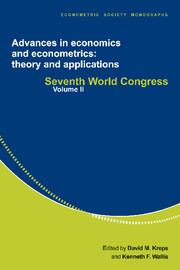Book contents
- Frontmatter
- 1 Incentives and careers in organizations
- 2 Endogenous growth: lessons for and from economic history
- 3 Microtheory and recent developments in the study of economic institutions through economic history
- 4 Poverty traps
- 5 Microenterprise and macropolicy
- 6 Markets in transition
- 7 Transition as a process of large-scale institutional change
- 8 A Schumpeterian perspective on growth and competition
- 9 Learning and growth
- Index
2 - Endogenous growth: lessons for and from economic history
Published online by Cambridge University Press: 05 January 2013
- Frontmatter
- 1 Incentives and careers in organizations
- 2 Endogenous growth: lessons for and from economic history
- 3 Microtheory and recent developments in the study of economic institutions through economic history
- 4 Poverty traps
- 5 Microenterprise and macropolicy
- 6 Markets in transition
- 7 Transition as a process of large-scale institutional change
- 8 A Schumpeterian perspective on growth and competition
- 9 Learning and growth
- Index
Summary
INTRODUCTION
In a survey of economic history written in the mid 1980s, I wrote that “economic history has had little influence upon and has been relatively little affected by growth theory of the postwar variety” (Crafts (1987, p. 40)). Clearly, growth accounting had been highly influential for measurement purposes but, at that point, for economic historians keen to understand productivity growth in terms of induced innovation or endogenous technological change, economic theory had little to offer, as the review of the well-known Habakkuk debate in David (1975) had made painfully obvious.
Since the mid 1980s, endogenous growth theory has developed very rapidly and has produced a large volume of theoretical research. At the core of these models is the proposition that investment in a broad sense, including human as well as physical capital and the production of new processes and products through research, is central to growth which can be driven on without being halted by diminishing returns.
One branch of endogenous growth theory obtains results by arguing for constant returns to routine investment in broad capital with the production function, Y = AǨ, as in Rebelo (1991). The key to rapid long-run growth is to be found in cultures, institutions, and tax policies which make a high rate of saving optimal. In this “capital-fundamentalist” approach there is no explicit role for total factor productivity (TFP), growth, or technological change. Despite the initial appeal of ideas of this kind, they are not persuasive as models of long-run growth. For example, cross-sectional regression evidence on the growth of GDP across countries (Mankiw, Romer and Weil (1992), Islam (1995)) and on output across British manufacturing sectors (Oulton and O‘Mahony (1994)) suggests that the sum of the exponents on physical and human capital in the production function is less than one and that there are diminishing returns to routine investment in the long run.
- Type
- Chapter
- Information
- Advances in Economics and Econometrics: Theory and ApplicationsSeventh World Congress, pp. 38 - 78Publisher: Cambridge University PressPrint publication year: 1997
- 2
- Cited by

